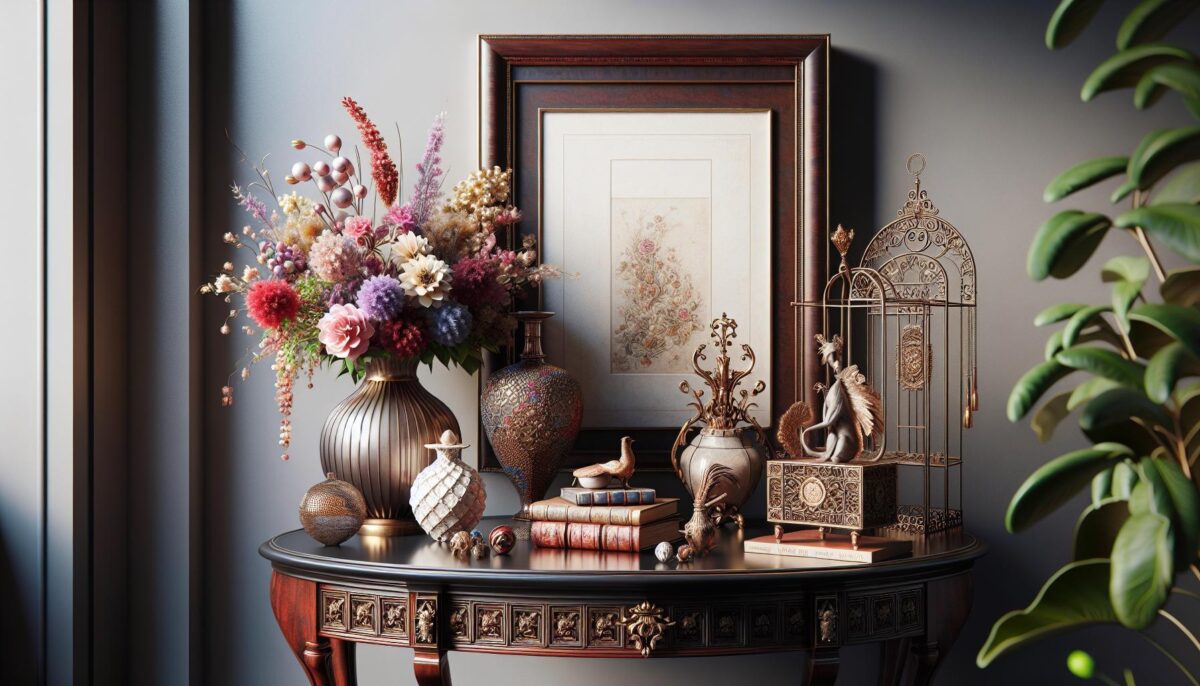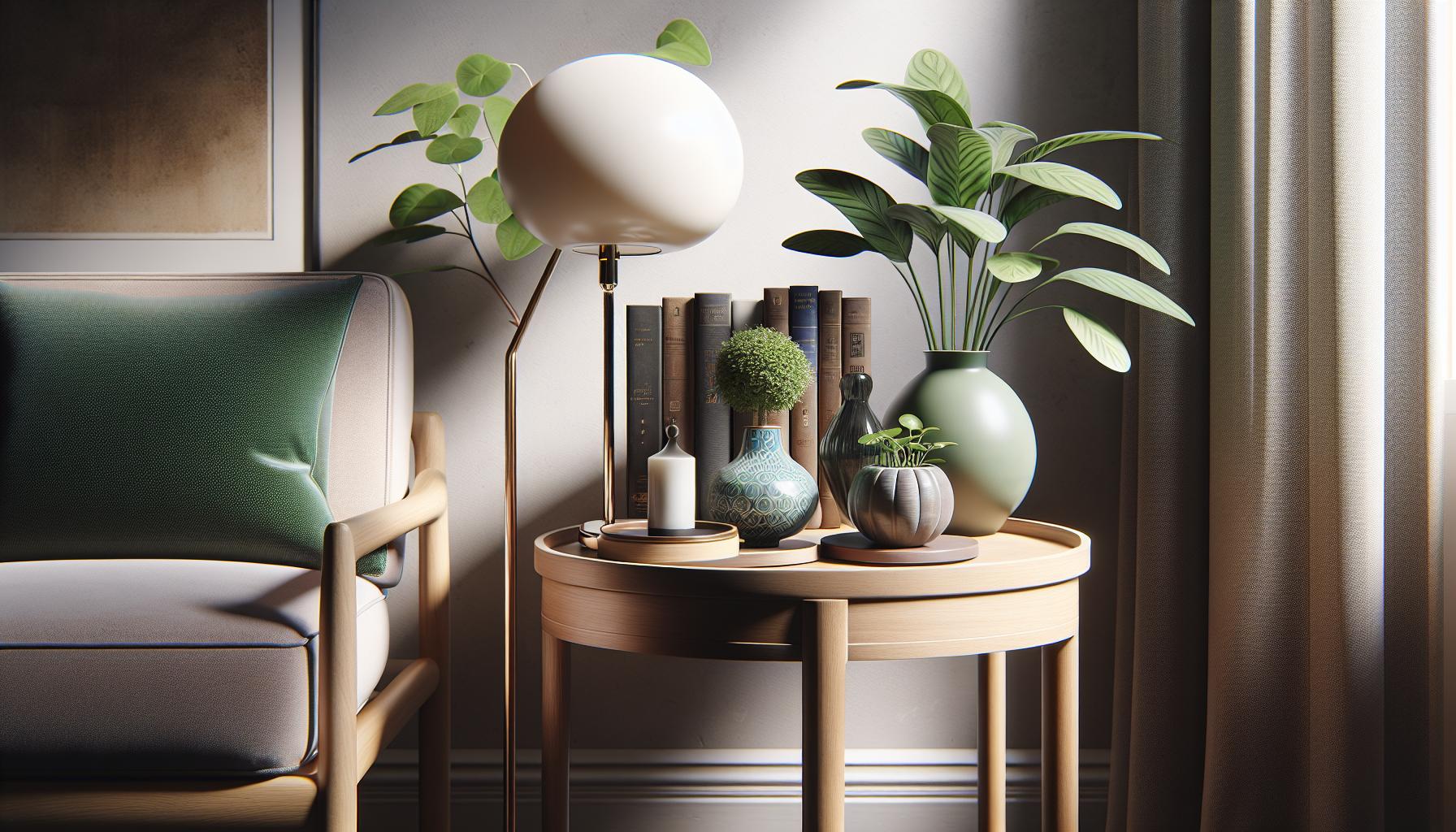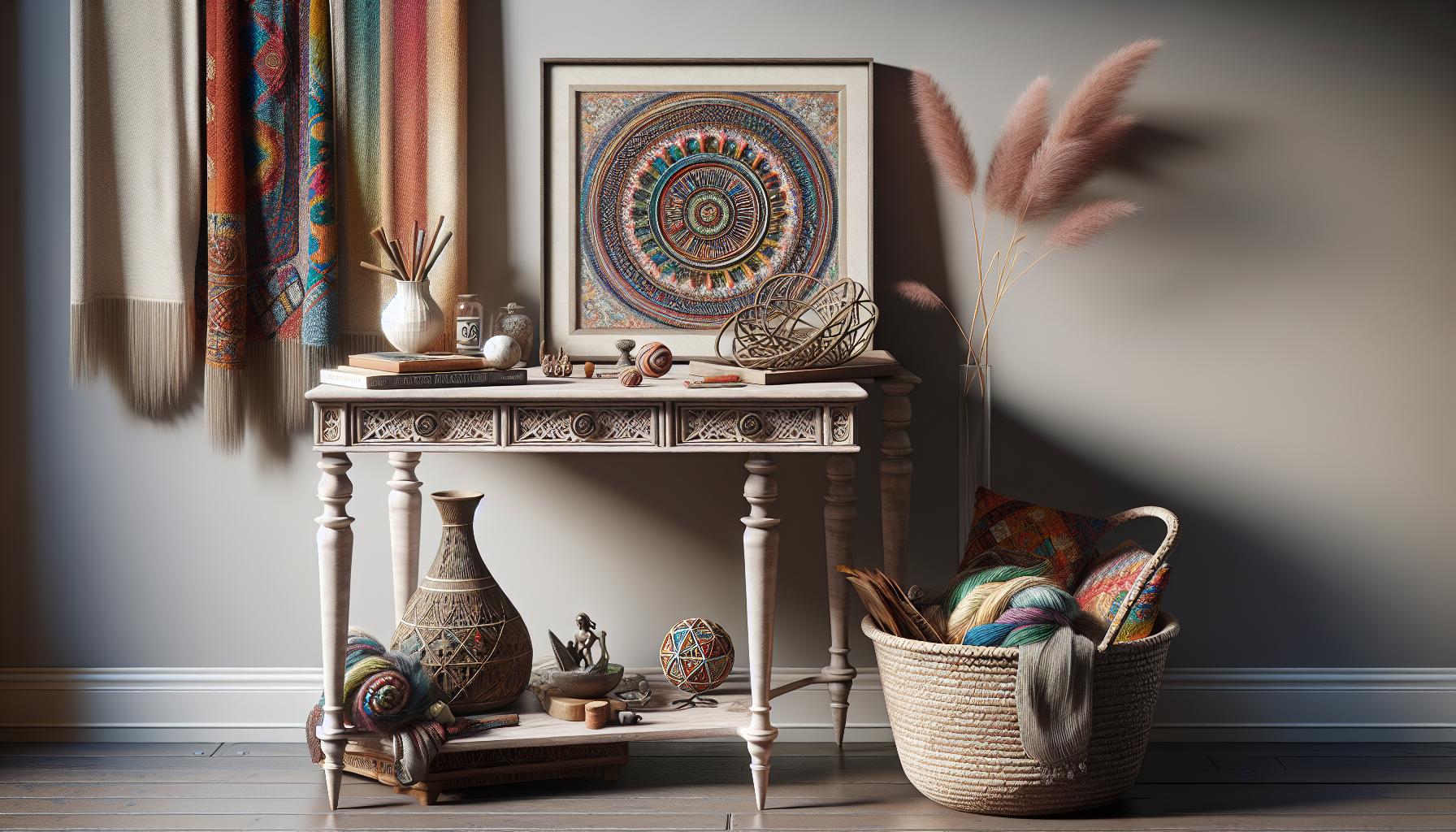Side Table Decor Ideas: Personalize Your Space Effortlessly

Side table/end table decor ideas can transform any living space from mundane to magazine-worthy with just a few strategic touches. It’s not just about where you set your drink down; it’s an opportunity to inject style, function, and flair into your room.
We’ve all seen those perfectly styled end tables in interior design magazines, making us wonder how we can achieve the same look in our own homes. Well, we’re here to break it down for you. With a mix of creativity and practical tips, we’ll show you how to elevate your side tables into eye-catching elements that reflect your personal style.
Choosing the Right Side Table
When we dive into the realm of side or end tables, recognizing that every detail counts is paramount. These small pieces can either subtly enhance the aesthetic of a space or become standout features on their own. It starts with selecting the right side table that not only fits but elevates our living room’s look.
First and foremost, size matters. We shouldn’t overlook the height and width of the end tables as they need to complement the existing furniture. Ideally, the table should be equal in height to the arm of the chair or sofa it’s next to or slightly shorter. This ensures convenience and a seamless look. Regarding width, making sure there’s enough surface area to hold essential items without it looking cluttered is key.
Material and Style align closely with the overall design theme of our room. Whether we’re aiming for a modern, minimalist vibe with glass and metal or a warm, rustic feel with wood, the table’s material plays a crucial role in tying the room together. And, of course, the style should mirror or complement the room’s existing décor. A mismatched piece can stick out awkwardly, disrupting the harmony we’ve worked so hard to achieve.
Lastly, considering functionality is crucial. Some tables come with built-in storage options like drawers or shelves, which can be a game-changer for those of us needing extra space. Whether we’re looking for a place to stash away remotes, books, or decorative items, checking for additional features that meet our needs can make a world of difference.
As we continue exploring the best ways to select the perfect side or end table, keeping these key points in mind ensures not just a functional space, but one that reflects our personal style and flair.
Understanding the Purpose of Your Side Table

Before diving headfirst into decoration, it’s crucial to get a clear picture of what role the side table will play in your space. Is it going to be a mere decorative piece, or will it serve a more functional purpose? We’ve noticed that understanding this can significantly influence our decor choices, ensuring we make the most out of our side tables without sacrificing style or functionality.
For those of us aiming for a blend of aesthetics and utility, thinking about the side table as an extension of our lifestyle is a good strategy. Whether it’s holding our morning coffee, storing our current reads, or showcasing our favorite houseplants, our side table can be much more than just a piece of furniture. It becomes a small yet significant part of our daily routines, enhancing the quality and comfort of our living area.
Moreover, by acknowledging the side table’s purpose, we’re in a better position to decide on the specifics. Size, shape, and material choice all hinge on how we plan to use it. A glass-top table might look sleek and modern but might not be the best choice if we’re planning to stack heavy books on it. Similarly, a smaller table could be perfect for tight spaces but might fall short in terms of storage or display capabilities.
Let’s also consider the visual aspect. A well-chosen side table can act as a focal point, drawing the eye and tying the room’s decor together. This is where understanding its purpose again comes into play. A table meant to spotlight a vintage lamp will have different requirements from one designed to keep our essentials within arm’s reach.
In essence, diving into the purpose behind our side table not only clarifies our decor vision but also streamlines the selection process, ensuring we end up with a piece that’s both functional and fitting with our aesthetic goals. It’s about creating harmony between form and function, where each side table uniquely contributes to the ambience and utility of our space.
Creating a Balanced Composition
When we’re styling our side tables, aiming for a balanced composition is key. Balance doesn’t necessarily mean symmetry. It’s more about distributing visual weight across the table in a way that feels intentional and pleasing to the eye. To achieve this, we consider a mix of items of varying heights, textures, and shapes. This not only adds interest but also ensures that no single item overwhelms the space or looks out of place.
To start, we select a anchor piece. This could be anything from a lamp with a sleek base to a chunky vase or a stack of hardcover books. This piece serves as a focal point and sets the tone for the rest of the decor. From there, we add smaller items, such as a decorative bowl, a candle, or a picture frame. These pieces should complement the anchor piece, not compete with it.
Here’s a simple guide we follow to create a balanced composition:
- Choose an anchor piece
- Add items of varying heights and textures
- Incorporate organic elements like plants or flowers
- Leave some space free to avoid clutter
Layering is another technique we use to add depth and interest. By placing some items slightly in front or behind others, we create a sense of depth that makes the arrangement more engaging. However, it’s crucial to remember that less is often more. We’re cautious not to overcrowd the table, as too many items can make it difficult to use the table for its intended purpose.
| Element | Importance |
|---|---|
| Anchor Piece | Sets the tone and focal point |
| Varying Heights | Adds interest and balance |
| Organic Elements | Brings life and softness |
| Free Space | Avoids clutter and maintains functionality |
By keeping these principles in mind, we’re able to create side table compositions that are not only beautiful but also balanced and reflective of our personal style.
Incorporating Functional Elements
While we’re focused on elevating the aesthetic appeal of side tables, we can’t overlook the importance of functionality. After all, our homes should not only look good but also serve our needs effectively. Incorporating functional elements into your side table decor can bridge the gap between form and function, ensuring that beauty doesn’t compromise utility.
One key strategy is to choose items that double as storage solutions. Decorative boxes or baskets can be both eye-catching and practical, offering a home for remotes, coasters, or reading glasses. By selecting these items with care, we ensure our side tables remain clutter-free while still being stylish.
Another aspect to consider is lighting. A well-chosen lamp can serve as both a focal point and a source of illumination. This is particularly crucial in living rooms or bedrooms where ambient lighting is key to creating a cozy atmosphere. Opt for lamps that complement the overall design theme but also provide the right amount of light for the space.
It’s also worth incorporating personal touches that reflect your lifestyle and interests. If you’re an avid reader, a small, chic book stand that holds your current read can add a personalized touch while keeping your table organized. For those who enjoy a cup of tea or coffee by their side, a resistant coaster set can blend in with your decor and protect the table surface.
Lastly, we mustn’t forget about plants. Incorporating small potted plants or succulents can add a burst of life and color. Not only do they enhance the visual appeal, but they also purify the air—melding beauty with health benefits.
By weaving these functional elements into our side table decor, we strike a perfect balance between practicality and aesthetics. Our chosen pieces aren’t just for show; they enhance our living spaces and reflect our personal tastes while serving their intended purpose.
Showcasing Personal Style

When it comes to decorating our side tables, showcasing our personal style isn’t just an option, it’s essential. This unique flair is what transforms a functional piece of furniture into a statement piece that speaks volumes about ours tastes and preferences. By carefully selecting items that resonate with our personal aesthetic, we can create a space that’s not only functional but also deeply personal.
Personal style can be reflected through a variety of mediums. Artwork offers a bold way to express our personality, whether it’s a small sculpture that intrigues us or a framed piece of art that we love. Color schemes play a crucial role as well; vibrant colors can energize a space, while softer hues might create a more serene atmosphere. Textural elements like a woven basket or a soft, luxurious throw can add depth and interest, making the side table feel more inviting.
It’s also important to consider the stories behind our items. A souvenir from a memorable vacation, a cherished heirloom, or a handmade gift from a friend not only adds character to our side table decor but also imbues it with memories and meaning. These pieces act as conversation starters and add a layer of richness to our decor that mass-produced items simply cannot replicate.
Finally, integrating our hobbies and interests into the decor can make the side table uniquely ours. Whether it’s showcasing a collection of vintage cameras for photography enthusiasts or arranging a selection of beloved books for avid readers, these touches ensure our side table is a direct reflection of our passions.
Incorporating elements that reflect our personal style not only elevates the design of our space but also creates an environment where we feel truly at home. As we curate items for our side tables, it’s crucial to select pieces that speak to us on a personal level, ensuring our decor is as unique as we are.
Conclusion
We’ve explored a myriad of ways to bring our side tables to life, emphasizing the power of personal style in transforming these spaces. By carefully selecting items that resonate with our aesthetic and incorporating elements that tell our stories, we’ve learned how to craft spaces that not only look stunning but feel deeply personal. Let’s remember, the beauty of decorating our side tables lies in the freedom to express ourselves. Whether it’s through the colors we love, the textures that speak to us, or the mementos that hold special meaning, each choice we make is a step towards creating a home that truly reflects who we are. So let’s embrace this opportunity to showcase our unique style and turn our side tables into meaningful, stylish expressions of our personalities.
Frequently Asked Questions
How can I make my side table reflect my personal style?
By selecting items that resonate with your aesthetic preferences like artwork, colors, and textures. Incorporating items with personal stories, like souvenirs or heirlooms, also adds character and makes your side table uniquely yours.
What is the importance of showcasing personal style in side table decor?
Showcasing personal style transforms a functional side table into a statement piece that reflects your tastes and preferences, creating an environment where you feel truly at home.
How can I add meaning to my side table decor?
Consider integrating items with personal stories, such as souvenirs from travels or family heirlooms. These pieces add depth, character, and meaning to your decor, making it more personalized and reflective of your journey.
Can hobbies and interests be incorporated into side table decor?
Yes, integrating your hobbies and interests into the decor can make your side table more personal and engaging. Whether it’s a collection of vintage cameras, stacks of your favorite books, or small pieces related to your hobbies, these elements showcase your personality.
What items are suggested for adding personal style to a side table?
Items that resonate with your personal aesthetic, like artwork, specific color schemes, and textural elements, are recommended. Additionally, consider including items with sentimental value or that tell a story to add depth and character to your decor.